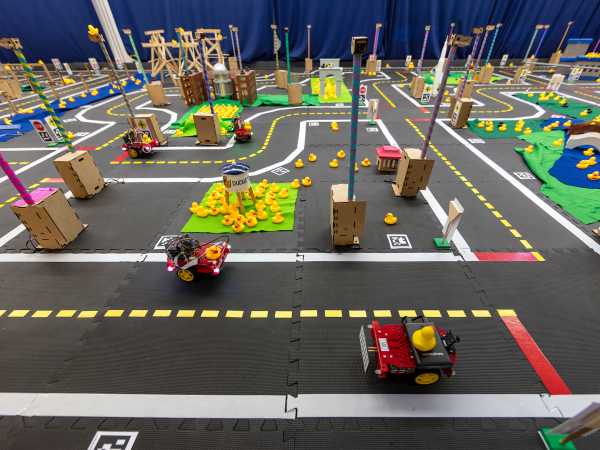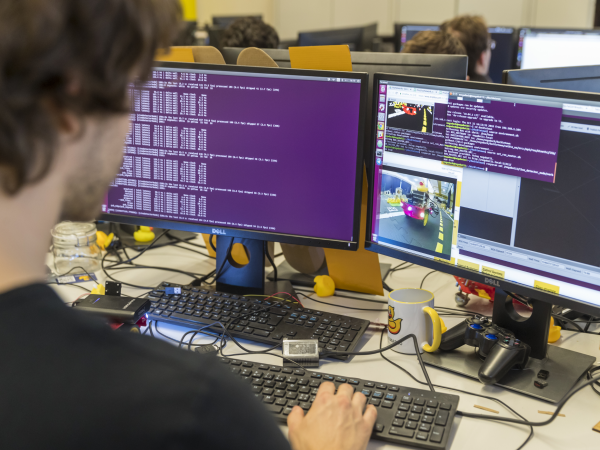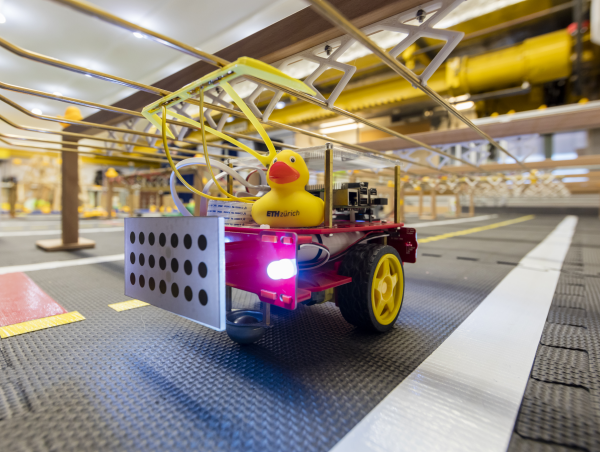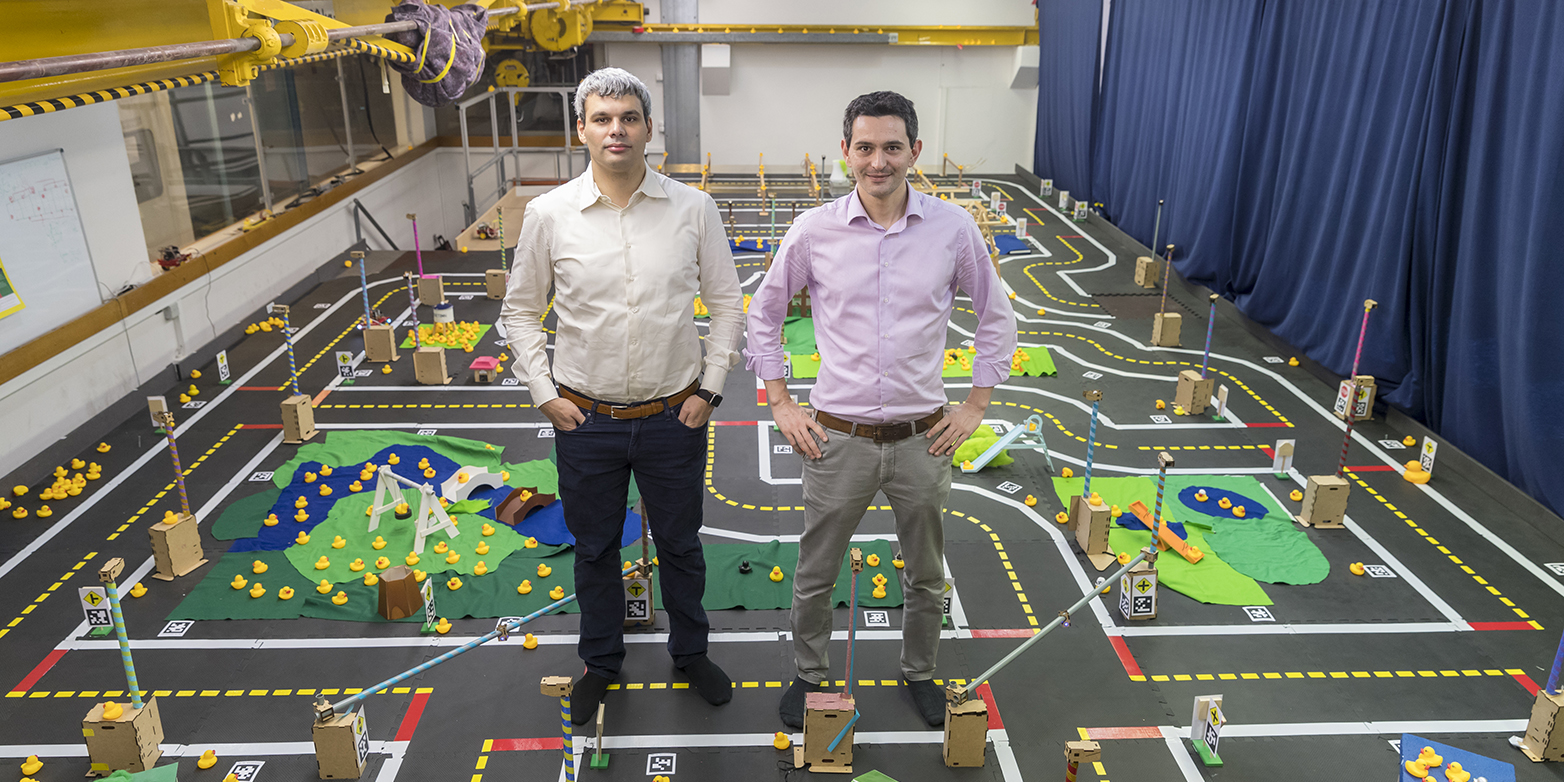AI behind the wheel in Duckietown
Researchers from ETH Zurich want to know what roles artificial intelligence (AI) can take on in self-driving cars. To find out, they are having research teams compete against each other in an international competition with the robot taxi fleets of Duckietown.
Researchers from ETH Zurich have launched a new competition for autonomous driving. The playing field for the competition is Duckietown. In this model town, small self-driving taxis equipped with a minicomputer, a camera, and a few LEDs transport ducklings from A to B. The platform was created at the Massachusetts Institute of Technology (MIT) and developed further at ETH Zurich.
The participants in the “Artificial Intelligence Driving Olympics”, abbreviated as “AI-DO”, have to teach these little robot taxis to stay in their lane, recognise objects and to avoid them or to interact with them as part of the complete taxi fleet in Duckietown.
Andrea Censi and Jacopo Tani, assistants to ETH Professor Emilio Frazzoli, came up with the idea for the competition. They would like to use the event to test the limits and possibilities of machine learning in physical robots.
Can artificial intelligence steer cars?
The research question to be investigated in the competition: Can artificial intelligence (AI) soon make an active contribution to steering autonomous vehicles in the streets? Today, machine learning helps cars to do things like detect objects. But it does not actively make decisions. “Some robotics researchers think that this will soon be possible. Censi remains sceptical. “But if my colleagues believe that they can implement that on real streets, then they should be able to do that in Duckietown easily,” he says with a chuckle. “They can prove it in our competition.”
Participants receive access to a basic code, simulators in the Amazon cloud, and the so-called robotarium: an autonomous Duckietown platform with remote access that Jacopo Tani and his team have developed and built in the mechanics lab at ETH Zurich. In the qualification phase, teams from around the world work on the code for different tasks. Using “containers” – packets of code that can be implemented on the robots at the touch of a key – they can test and then ultimately set up their code.
 The robotics experts can access the system remotely.
The robotics experts can access the system remotely. When they run out of batteries, the tiny robot cars drive themselves back to charge up. In other words, the system is completely autonomous.
When they run out of batteries, the tiny robot cars drive themselves back to charge up. In other words, the system is completely autonomous.
Finals at the Machine Learning Conference in Montreal
The competition has been running since mid-October. The best teams will qualify for the final on 7 December at the popular Machine Learning Conference “Neural Information Processing Systems” (NIPS) in Montreal. There they will face off against each other in a Duckietown robotarium on the conference site. The team whose code can steer the robot taxis through Duckietown with the fewest errors wins. It’s up to the teams to decide which types of tasks AI is used for and where conventional methods are applied.
Censi is convinced that the actual competition will be between a handful of top researchers. But because the participants receive some basic codebuilding blocks, the entry threshold is low. Master’s degree students at ETH Zurich are also participating as part of one of their courses. And it should even be possible for interested amateurs to make the robot taxis drive. They will hardly be able to hope to win. But that’s not the sole point of the competition says Censi: “The competition functions as both an area for playing and experimenting. We are glad if as many people as possible have their curiosity sparked and find a way to approach robotics. That’s the foundation for learning how the technology of tomorrow works.”
From simulation to reality
But the primary motivation for the competition is concrete research interest. Censi says: “Machine-learning researchers often don’t have such easy access to a robotics platform. That’s why a lot of problems arise that they’ve never encountered before. With AI-DO we want to promote the exchange of ideas between robotics specialists and the machine-learning experts.”
Censi hopes to find new ideas generated by the project for the so-called transfer problem: it’s only possible to train robots for safety-critical functions in simulations. But after that it has to function in the real world environment. AI-DO offers both – virtual simulations and also a real physical environment with the robotariums. So researchers can practice taking this step into the physical world at the competition.
In addition to ETH Zurich, the Université de Montréal, the National Chiao Tung University in Taiwan, the Toyota Technological Institute at Chicago, the Georgia Institute of Technology and the Tsinghua University in China are involved in the project. Amazon Web Services and nuTonomy, a developer of self-driving taxis in Singapore, are working on the project too.
Reference
Censi A, Paull L, Tani J et al. The AI Driving Olympics at NIPS 2018. external pagehttps://arg-nctu.github.io/publications/paull-2018-nips-AIDO.pdfcall_made

